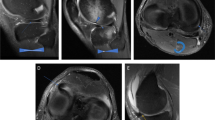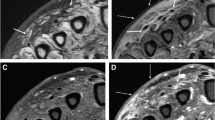Abstract
Juvenile idiopathic arthritis (JIA) is the most common chronic rheumatic disease of childhood. Enthesitis-related arthritis (ERA) has been one of the most controversial subtypes of JIA with a higher risk of axial involvement. Our aim was to assess the frequency and spectrum of MRI findings of spine involvement in patients with JIA and determine if the axial involvement is always clinically symptomatic in patients with positive MRI findings. In this retrospective cross-sectional observational study we included known or suspected JIA patients who underwent spinal MRI examination between 2015 and 2017 and followed up in the Pediatric Rheumatology outpatient clinic. The demographic and clinical data were reviewed from the medical charts and electronic records. All patients were grouped as clinically symptomatic and asymptomatic for spinal involvement and MRI findings were re-evaluated for presence of inflammatory and erosive lesions. Of the 72 JIA patients, 57 (79.2%) were diagnosed with ERA, and 15 (20.8%) with non-ERA subtypes of JIA. Overall, 49 (68%) patients with JIA had positive spinal MRI findings (inflammatory and/or erosive lesions). Twenty-seven (47%) ERA patients were clinically symptomatic for spine involvement and among them, 19 (70.3%) had positive spinal MRI findings. Although 30 ERA (53%) patients were clinically asymptomatic, 23 of them (77%) had positive spinal MRI findings, as well. Eleven (73%) patients diagnosed with non-ERA JIA subtypes were clinically symptomatic for spine involvement at the time of MRI. Among them, four (36.3%) had inflammatory and/or erosive lesions on spine MRI. Four (26%) non-ERA patients were clinically asymptomatic for spine involvement, but three (75%) of them showed positive findings on spinal MRI. Inflammatory and/or erosive lesions of the thoracolumbar spine could exist in patients with JIA, regardless of the presence of symptoms. Not only because the significant proportion of ERA patients show asymptomatic axial involvement but also the presence of axial involvement in patients who were classified as non-ERA depending on current ILAR classification underlines the necessity of using MRI for accurate classification of patients with JIA.




Similar content being viewed by others
References
Cimaz R, Marino A, Martini A (2017) How I treat juvenile idiopathic arthritis: a state of the art review. Autoimmun Rev 16(10):1008–1015
Bombardier C, Gladman DD, Urowitz MB et al. (1992) Derivation of the SLEDAI. A disease activity index for lupus patients. The Committee on Prognosis Studies in SLE. Arthritis Rheum 35(6):630–640
Giancane G, Consolaro A, Lanni S et al. (2016) Juvenile idiopathic arthritis: diagnosis and treatment. Rheumatol Ther 3(2):187–207
Petty RE, Southwood TR, Manners P et al (2004) International League of Associations for Rheumatology classification of juvenile idiopathic arthritis: second revision, Edmonton, 2001. J Rheumatol 31(2):390–392
Rudwaleit M, van der Heijde D, Landewe R et al. (2009) The development of Assessment of SpondyloArthritis international Society classification criteria for axial spondyloarthritis (part II): validation and final selection. Ann Rheum Dis 68(6):777–783
Colebatch-Bourn AN, Edwards CJ, Collado P et al (2015) EULAR-PReS points to consider for the use of imaging in the diagnosis and management of juvenile idiopathic arthritis in clinical practice. Ann Rheum Dis 74(11):1946–1957
Tse SM, Laxer RM (2012) New advances in juvenile spondyloarthritis. Nat Rev Rheumatol 8(5):269–279
Burgos-Vargas R (2002) The juvenile-onset spondyloarthritides. Rheum Dis Clin North Am 28(3):531–560
Petty RELR, Lindsley CB et al. (2016) Textbook of pediatric rheumatology, 7th edn. Elsevier, Philadelphia, pp 238–256
Weiss PF, Chauvin NA (2020) Imaging in the diagnosis and management of axial spondyloarthritis in children. Best Pract Res Clin Rheumatol 34(6):101596
Sudol-Szopinska I, Gietka P, Znajdek M et al (2017) Imaging of juvenile spondyloarthritis. Part I: Classifications and radiographs. J Ultrason 17(70):167–175
Mandl P, Navarro-Compan V, Terslev L et al (2015) EULAR recommendations for the use of imaging in the diagnosis and management of spondyloarthritis in clinical practice. Ann Rheum Dis 74(7):1327–1339
Bollow M, Biedermann T, Kannenberg J et al (1998) Use of dynamic magnetic resonance imaging to detect sacroiliitis in HLA-B27 positive and negative children with juvenile arthritides. J Rheumatol 25(3):556–564
Davies K, Copeman A (2006) The spectrum of paediatric and adolescent rheumatology. Best Pract Res Clin Rheumatol 20(2):179–200
Vendhan K, Sen D, Fisher C et al (2014) Inflammatory changes of the lumbar spine in children and adolescents with enthesitis-related arthritis: magnetic resonance imaging findings. Arthritis Care Res (Hoboken) 66(1):40–46
Weiss PF, Beukelman T, Schanberg LE et al (2012) Enthesitis-related arthritis is associated with higher pain intensity and poorer health status in comparison with other categories of juvenile idiopathic arthritis: the Childhood Arthritis and Rheumatology Research Alliance Registry. J Rheumatol 39(12):2341–2351
Gmuca S, Weiss PF (2015) Evaluation and treatment of childhood enthesitis-related arthritis. Curr Treatm Opt Rheumatol 1(4):350–364
Poddubnyy D (2013) Axial spondyloarthritis: is there a treatment of choice? Ther Adv Musculoskelet Dis 5(1):45–54
Haibel H, Brandt HC, Song IH et al (2007) No efficacy of subcutaneous methotrexate in active ankylosing spondylitis: a 16-week open-label trial. Ann Rheum Dis 66(3):419–421
Ringold S, Angeles-Han ST, Beukelman T et al (2019) 2019 American College of Rheumatology/Arthritis Foundation guideline for the treatment of juvenile idiopathic arthritis: therapeutic approaches for non-systemic polyarthritis, sacroiliitis, and enthesitis. Arthritis Rheumatol 71(6):846–863
Flato B, Hoffmann-Vold AM, Reiff A et al (2006) Long-term outcome and prognostic factors in enthesitis-related arthritis: a case-control study. Arthritis Rheum 54(11):3573–3582
Minden K, Niewerth M, Listing J et al (2002) Long-term outcome in patients with juvenile idiopathic arthritis. Arthritis Rheum 46(9):2392–2401
Weiss PF, Xiao R, Biko DM et al (2016) Assessment of sacroiliitis at diagnosis of juvenile spondyloarthritis by radiography, magnetic resonance imaging, and clinical examination. Arthritis Care Res (Hoboken) 68(2):187–194
Toiviainen-Salo S, Markula-Patjas K, Kerttula L et al (2012) The thoracic and lumbar spine in severe juvenile idiopathic arthritis: magnetic resonance imaging analysis in 50 children. J Pediatr 160(1):140–146
Bouchaud-Chabot A, Liote F (2002) Cervical spine involvement in rheumatoid arthritis. A review Joint Bone Spine 69(2):141–154
Neva MH, Hakkinen A, Makinen H et al (2006) High prevalence of asymptomatic cervical spine subluxation in patients with rheumatoid arthritis waiting for orthopaedic surgery. Ann Rheum Dis 65(7):884–888
Elhai M, Wipff J, Bazeli R et al (2013) Radiological cervical spine involvement in young adults with polyarticular juvenile idiopathic arthritis. Rheumatology (Oxford) 52(2):267–275
Hospach T, Maier J, Muller-Abt P et al (2014) Cervical spine involvement in patients with juvenile idiopathic arthritis—MRI follow-up study. Pediatr Rheumatol Online J 12:9
Author information
Authors and Affiliations
Corresponding author
Additional information
Publisher's Note
Springer Nature remains neutral with regard to jurisdictional claims in published maps and institutional affiliations.
Rights and permissions
About this article
Cite this article
Demir, S., Ergen, .B., Taydaş, O. et al. Spinal involvement in juvenile idiopathic arthritis: what do we miss without imaging?. Rheumatol Int 42, 519–527 (2022). https://doi.org/10.1007/s00296-021-04890-8
Received:
Accepted:
Published:
Issue Date:
DOI: https://doi.org/10.1007/s00296-021-04890-8




